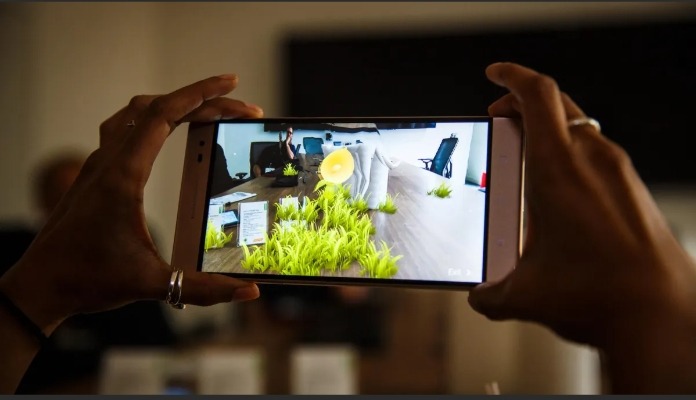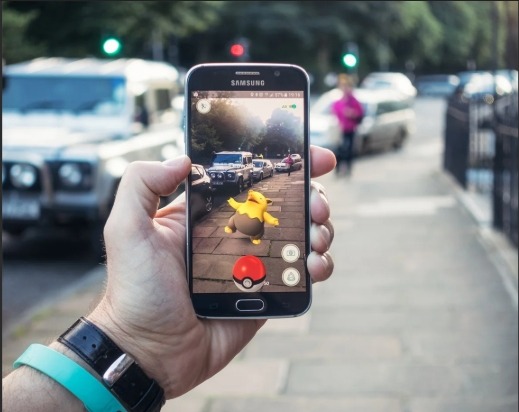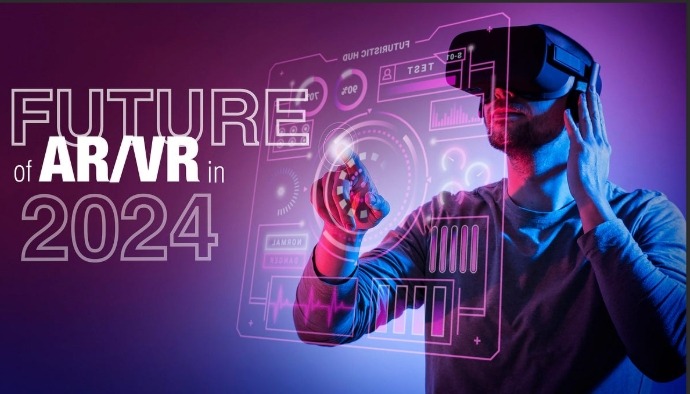Introduction
Smartphones with AR/VR Capabilities: AR (Augmented Reality) and VR (Virtual Reality) capabilities are revolutionizing the smartphone industry, pushing the boundaries of how we interact with technology. From immersive gaming experiences to innovative applications in education and virtual meetings, these technologies are enhancing our digital lives in unprecedented ways. Smartphones equipped with AR/VR capabilities are no longer just gadgets—they are portals to transformative experiences that merge the virtual and physical worlds.
The demand for smartphones with Smartphones with AR/VR Capabilities is growing rapidly as users seek more immersive and interactive tools. Gamers are exploring lifelike virtual realms, educators are introducing interactive learning environments, and professionals are leveraging VR for virtual collaborations—all from the convenience of a smartphone. The versatility and applications of Smartphones with AR/VR Capabilities make it an essential feature for both casual users and tech enthusiasts.
In this blog, we’ll unveil the Top 5 Smartphones with AR/VR Capabilities in 2025, exploring their unique features, performance, and how they deliver cutting-edge immersive experiences. Whether you’re a gamer, a professional, or simply curious about the future of mobile technology, this list will guide you toward the perfect AR/VR-ready device for your needs. Stay tuned to discover the next level of innovation!
1.Why AR/VR Capabilities Matter in Smartphones

Transforming User Experiences with AR/VR
Smartphones with AR/VR Capabilities (Augmented Reality) and VR (Virtual Reality) are redefining how we interact with the world through our smartphones. With AR/VR capabilities, everyday activities are becoming more immersive and engaging:
- Gaming: Smartphones with AR/VR capabilities offer lifelike experiences, allowing gamers to explore virtual worlds or interact with augmented environments in real time.
- Online Shopping: AR enables users to virtually try on clothes, accessories, or even preview furniture in their homes before making a purchase.
- Education: Learning becomes more interactive, as AR and VR can simulate historical events, complex scientific processes, or virtual labs, providing students with hands-on experiences.
By merging the virtual and physical worlds, AR/VR technology is enhancing user experiences in ways we never thought possible.
Benefits for Casual Users and Professionals
The versatility of smartphones with AR/VR capabilities makes them valuable for a wide range of users:
- Casual Users: These smartphones bring entertainment to a new level, from immersive gaming and streaming to augmented fitness apps that transform workout routines.
- Professionals: Architects and designers can use AR/VR to create virtual blueprints or 3D models, while healthcare professionals can conduct virtual consultations and train using VR simulations.
Whether for productivity, entertainment, or education, these Smartphones with AR/VR Capabilities are bridging the gap between convenience and innovation for both personal and professional needs.
Shaping the Future of Mobile Innovation
The integration of Smartphones with AR/VR Capabilities in smartphones is setting the stage for groundbreaking advancements:
- Hardware Evolution: Smartphones are now equipped with high-refresh-rate displays, powerful GPUs, and advanced motion-tracking sensors to handle AR/VR tasks seamlessly.
- New Applications: With the rise of augmented social media filters, virtual meeting rooms, and immersive e-commerce, AR/VR is expanding the horizons of smartphone applications.
- The Path to the Metaverse: Smartphones are becoming essential tools in the development and accessibility of the Metaverse, allowing users to explore interconnected virtual spaces directly from their devices.
As AR/VR continues to evolve, smartphones with AR/VR capabilities are at the forefront of mobile innovation, shaping how we interact, work, and entertain ourselves.
Click Here: Top 5 : Best Small & Compact Smartphones to buy in 2025
2. Top 5 Smartphones with AR/VR Capabilities in 2025

1 Apple iPhone 16 Pro Max: The AR/VR Pioneer
- AR/VR-Ready Display: Features a stunning Super Retina XDR display with a 120Hz refresh rate, ensuring fluid visuals for immersive augmented and virtual reality experiences.
- Powerful Processor: Powered by the A18 Bionic chip, optimized for AR/VR applications, delivering seamless performance without lag.
- Unique Features: Advanced LiDAR technology enables precise spatial mapping, making it perfect for gaming, design, and interactive apps.
2 Samsung Galaxy Z Fold6: Immersive Screen Technology
- Immersive Display: A foldable 7.6-inch Dynamic AMOLED display that transforms into a VR-ready canvas for unmatched visuals.
- Performance: Equipped with the Exynos 2500 processor and cutting-edge AI-driven enhancements, ensuring smooth AR/VR operations.
- Special Features: Multi-screen mode allows users to integrate AR/VR experiences across the unfolded display.
3 Google Pixel 8 Pro: AR/VR Software Excellence
- Software Support: Features Google’s advanced ARCore platform, delivering robust augmented reality capabilities and VR application compatibility.
- Design: Crafted with precision, its lightweight design makes it ideal for extended AR/VR sessions.
- Performance: Powered by the Tensor G3 chip, it efficiently handles complex AR tasks with ease.
4 OnePlus 12T Pro: Hardware Innovations
- Hardware Excellence: Incorporates a high-refresh-rate AMOLED display and Snapdragon 8 Gen 4 processor optimized for AR/VR rendering.
- Innovations: Features advanced motion-tracking sensors and haptic feedback that heighten VR immersion.
- Applications: Perfect for gamers and creative professionals looking for immersive environments.
5 Xiaomi Mi Mix AR Edition: Budget-Friendly AR/VR Powerhouse
- Affordability and Features: Offers premium Smartphones with AR/VR Capabilities at a competitive price, making immersive technology accessible to more users.
- Display: A 6.7-inch AMOLED screen with VR-ready resolution and vibrant colors.
- Performance: Powered by MediaTek Dimensity 9200, ensuring efficient processing for AR and VR apps.
यह भी पढ़े: “Top 5 Eco-Friendly Smartphones of 2025: Sustainable Technology for a Greener Tomorrow”
3. Features That Make a Smartphone AR/VR-Ready

1.Advanced Processors and GPUs for Smooth AR/VR Experiences
At the core of any smartphone capable of handling Smartphones with AR/VR Capabilities is its processor and GPU. These components are responsible for running AR/VR applications with precision and speed:
- Advanced Processors: Chipsets like the Snapdragon 8 Gen series or Apple’s A18 Bionic are optimized to handle intensive AR/VR tasks, ensuring seamless rendering and lag-free performance.
- High-Performance GPUs: Graphics processors like the Adreno or Mali series deliver enhanced visual processing, allowing virtual environments to appear lifelike and immersive.
These processors and GPUs empower users to enjoy smooth, high-quality experiences in gaming, virtual tours, and augmented reality apps.
2. High-Resolution Displays and Refresh Rates for Visual Clarity
A smartphone’s display plays a pivotal role in Smartphones with AR/VR Capabilities usability by offering stunning visuals with enhanced clarity:
- High Resolution: Devices equipped with FHD+ or higher resolution screens ensure crisp and vivid visuals, making AR/VR interactions more immersive.
- Refresh Rate: Smartphones with 120Hz or 144Hz refresh rates provide fluid motion and reduce visual fatigue during prolonged AR/VR usage.
- AMOLED or OLED Displays: These screens deliver vibrant colors, deep contrasts, and better brightness levels, enhancing the realism of virtual environments.
These display specifications significantly contribute to delivering an unparalleled Smartphones with AR/VR Capabilities viewing experience.
3. Compatibility with AR/VR Headsets and Apps
Seamless integration with Smartphones with AR/VR Capabilities accessories and apps is key to maximizing the smartphone’s potential:
- Headset Compatibility: Devices that work well with VR headsets like the Oculus, HTC Vive, or Google Cardboard open doors to full-fledged virtual reality experiences.
- App Support: Platforms like Google’s ARCore and Apple’s ARKit provide extensive libraries of AR apps, allowing users to explore virtual designs, games, and even professional tools with ease.
Compatibility ensures that users can effortlessly pair their smartphones with external AR/VR devices for immersive sessions.
4. Enhanced Software Features Like Motion Tracking and Spatial Audio
Smartphones equipped with specialized software optimizations enhance the realism of Smartphones with AR/VR Capabilities:
- Motion Tracking: Built-in sensors like gyroscopes and accelerometers, paired with AI algorithms, enable accurate tracking of movements, essential for gaming and virtual tours.
- Spatial Audio: Cutting-edge audio enhancements make virtual environments feel lifelike by delivering three-dimensional sound that adapts to movement within AR/VR spaces.
- AI-Driven Features: Intelligent software can optimize battery usage, boost performance, and provide adaptive improvements to AR/VR apps.
These software features add depth and immersion to the overall experience, ensuring users fully engage with virtual worlds.
4. The Future of AR/VR in Smartphones

Predictions for AR/VR Technology Advancements in Mobile Devices
The integration of AR (Augmented Reality) and VR (Virtual Reality) in smartphones is poised for remarkable growth. Over the coming years, we can expect:
- Hardware Evolution: Smartphones will feature more powerful processors and GPUs tailored to handle AR/VR applications effortlessly. Advancements in AI will further optimize performance, enabling smoother interactions within virtual environments.
- Immersive Displays: Foldable and rollable screens could redefine AR/VR experiences, offering users larger and more adaptable displays. Ultra-high refresh rates, 4K resolutions, and AMOLED technology will ensure unparalleled visual clarity.
- Wearable Compatibility: Enhanced connectivity with AR/VR headsets will bring more seamless integration, expanding immersive possibilities across industries.
- Compact AR/VR Modules: Future smartphones may incorporate built-in AR/VR projectors or compact holographic displays, eliminating the need for external headsets altogether.
These advancements will make Smartphones with AR/VR Capabilities more accessible to everyday users, transforming how we interact with technology.
Potential Applications in Gaming, Education, Healthcare, and Entertainment
The versatility of AR/VR technology will see its applications expand across multiple fields:
- Education: AR will create virtual classrooms where students can experience interactive lessons, historical simulations, and virtual field trips, enhancing learning outcomes.
- Gaming: Hyper-realistic gaming environments where players can interact with virtual worlds more intuitively, bringing immersive storytelling and social gameplay to new heights.
- Healthcare: Medical professionals will benefit from AR/VR in training, diagnosis, and surgery simulations, enabling better precision and patient care.
- Entertainment: The film and music industries will embrace VR for creating immersive content, allowing audiences to step into virtual concerts, performances, and cinematic worlds.
As Smartphones with AR/VR Capabilities applications expand, smartphones will play a central role in delivering these experiences.
How AR/VR Capabilities Will Influence Smartphone Design in the Coming Years
The rise of Smartphones with AR/VR Capabilities technology will have a profound impact on smartphone design:
- Slimmer Yet More Powerful Devices: Manufacturers will pack advanced AR/VR hardware into sleek designs, ensuring portability without sacrificing functionality.
- Improved Sensors: Enhanced gyroscopes, accelerometers, and LiDAR technology will deliver better motion tracking and spatial mapping for precise AR/VR interactions.
- Battery Innovations: Energy-efficient processors and silicon-carbon batteries will ensure prolonged use during intensive AR/VR sessions.
- Sustainability: As AR/VR demands grow, smartphones will incorporate eco-friendly materials to offset the environmental impact of manufacturing.
These design changes will ensure smartphones remain the go-to devices for immersive technology, bridging the gap between innovation and user experience.
5. Tips for Choosing the Best AR/VR Smartphone

1.Key Specifications to Look For
When selecting an Smartphones with AR/VR Capabilities-ready smartphone, prioritize specifications that enhance immersive experiences:
- Display Quality: Opt for a smartphone with a high-resolution display (FHD+ or 4K) and a refresh rate of 120Hz or higher to ensure smooth visuals and minimal motion blur in virtual environments.
- Processing Power: Look for advanced processors like Snapdragon 8 Gen 4 or Apple’s A18 Bionic chip paired with a powerful GPU for seamless rendering and real-time performance during AR/VR interactions.
- Headset Compatibility: Ensure the smartphone is compatible with popular VR headsets like Oculus, HTC Vive, or Google Cardboard, as well as AR apps built on platforms like Google ARCore or Apple ARKit.
These specifications are crucial for delivering a high-quality Smartphones with AR/VR Capabilities experience without lags or interruptions.
2. Budget Considerations and Finding the Right Device
Set a Budget: AR/VR smartphones are available at various price points, so determine how much you’re willing to spend. Mid-range devices like the Google Pixel series can be an excellent balance of performance and price.
- Assess Needs: If you’re an avid gamer or professional requiring advanced AR/VR features, investing in a high-end model like the iPhone 16 Pro Max or Samsung Galaxy Z Fold6 is worth considering. For casual users, budget-friendly options like Xiaomi’s Mi Mix AR Edition can deliver satisfactory performance.
- Futureproofing: Invest in a smartphone with upgrade-ready specifications to keep up with AR/VR advancements for the next few years.
Balancing your budget with the device’s capabilities ensures you make the most cost-effective choice.
3. Exploring Brands Leading Innovation in AR/VR
Some smartphone brands are at the forefront of AR/VR innovation:
- Apple: Pioneering AR development with LiDAR sensors, ARKit platform, and top-tier processors.
- Samsung: Known for foldable devices and AMOLED displays, perfect for immersive experiences.
- Google: Delivers software optimization through ARCore and balanced hardware performance.
- OnePlus: Offers competitive features for motion tracking and haptic feedback on a budget.
- Xiaomi: Provides budget-friendly options without compromising on AR/VR functionality.
Exploring these brands helps you discover the best devices tailored to your requirements.
Conclusion
As we move further into 2025, AR/VR smartphones are shaping the future of technology, offering users immersive and interactive experiences that were once confined to science fiction. These devices are not only transforming gaming, education, and entertainment but are also driving advancements in industries like healthcare and virtual collaboration. With powerful processors, stunning displays, and innovative software, AR/VR smartphones unlock limitless possibilities for how we learn, work, and play.
Embracing these cutting-edge devices means stepping into a world of boundless creativity and connectivity. Whether you’re exploring virtual landscapes, attending AR-enabled classes, or engaging in immersive entertainment, AR/VR smartphones are at the forefront of mobile innovation, making it easier than ever to experience the future.

